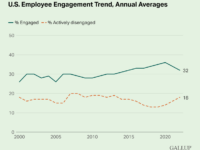No one knows what engaging hourly workers takes better than Carolyn Jackson.
Jackson joined The Coca-Cola Company (TCCC) in 1985, armed with an educational background in social sciences and labor relations, as well as professional experience working in the industrial sector at Armco Inc. and the National Supply Company. Over the following three decades, Jackson’s expertise propelled her through various executive-level HR and people management positions within the organization.
In 2012, she was appointed Senior Vice President of Human Resources for the Coca-Cola North America Group, where she was responsible for more than 60,000 employees. Jackson held this role until her retirement in 2016.
Early into her career, Jackson became an evangelist for the employee engagement potential of the industrial sector’s hourly workforce. This employee segment, Jackson argues, can make a significant positive impact on the company’s performance–they just need to be afforded the opportunities (and requisite trust) to do so.
Blue collar and white collar workers may differ in terms of roles, responsibilities, and the work they perform, but Jackson understands that their goals are very much aligned. By opening up lines of communication between these two worlds of work, a company-wide community can form around executing these goals with greater efficiency.
“That community can help the company build its brand and purpose to serve customers,” Jackson says. “I’ve worked in environments where we’ve trusted and done just that in an hourly community. I’ve worked in other environments where we did not.”
Jackson isn’t one to mince words. Across her career, she’s seen what’s possible when an hourly workforce is engaged and supported by company leaders–and she knows how quickly that progress can disappear when leaders’ support vanishes. In this Around the Bonfyre, Jackson shares an unflinching look at the hard work engaging hourly workers requires.
RELATED: 3 Strategies for Engaging Hourly Workers
Engaging hourly workers in the industrial sector
For the last 20 years, business leaders have used the term “employee engagement” to describe the next great frontier of performance potential. The idea is that if you can just get employees “tuned in, turned on, and eager to go above and beyond,” you’ll see a return in the form of every positive business outcome under the sun. But if engagement is a lens for viewing employee motivation and performance, then at many companies hourly workers remain excluded just out of focus.
Hourly workers make up nearly 60% of the U.S. labor force, which would lead one to think that engagement would be a top priority for this segment. However, in the industrial sector engaging hourly workers is an uphill battle. The high turnover this employee segment faces, mixed with a general lack of recognition of individual employees’ contributions, means senior leaders are usually gun-shy about engagement. They’d rather focus engagement efforts on salaried knowledge workers. instead.
Jackson sees things differently. She came to TCCC from the steel industry, where companies’ core competencies are built around the needs of a predominantly hourly workforce. Having witnessed what manufacturing employees can do when they’re engaged, Jackson says the organization suffers when senior leaders do not understand this population’s experiences.
“If you yourself haven’t been a part of that kind of community, you create an image in your head of what they like, what they don’t like, what they want and don’t want, versus getting the information and the facts about it,” Jackson says.
Jackson worked hard to build bridges between TCCC’s blue and white collar workforces. Leveraging feedback from employees at the organization’s plants via engagement surveys and exit interviews, she developed a number of “programmatic solutions” aligned with the company’s vision and higher purpose.
“You can share that vision with hourly employees so that they understand why their work is so important,” Jackson says. “What they do is so important, how it connects to the customer. You have a common purpose and a common goal.”
Notably, she oversaw a transition to self-directed work teams at a number of the organization’s syrup branches–a rarity in manufacturing settings. According to Jackson, these employee-led teams found innovative ways of rearranging their shifts to avoid the morning and evening rush hours without sacrificing plant productivity. At one point, she says they were even able to transition to a four-day work week.
Jackson credits these innovations to a big-picture style of thinking. Everyone wants to make decisions and everyone wants to feel like their voice matters–even hourly employees. If they don’t feel they have to “leave their brains at the door” when they start the day, innovation will follow.
“You have to think about this thing systemically, not in isolation. All those things we worked on in that kind of manufacturing setting, while it was a challenge, it worked. We saw higher engagement.”
Managers’ role in engaging hourly workers
Allowing employees to generate ideas and make their own decisions is only one part of what engaging hourly workers takes. These populations need to be supported by supervisors and managers who can lead teams with engagement in mind.
“All the engagement data tells you, ‘Yeah I need to know the purpose, mission, and hopefully understand where my department fits,’” Jackson says. “But at the end of the day, the person who either makes me have a good or bad mood is my supervisor or manager. If they’re not bought in, then it’s just a roll down effect.”
At TCCC, Jackson helped implement something called “Frontline Supervisor Training.” The curriculum helped supervisors and managers in the organization’s plants develop competencies around managing conflict, holding “fierce conversations” with employees, and understanding and fulfilling the expectations of their leadership roles. She characterizes this sort of training as an investment, but a necessary one for engaging hourly workers.
“When we were able to build trust, it was because we sent our supervisors and middle-level managers through training,” Jackson says. “When we would invest in training, our engagement scores went up.”
But the fact that training is an “investment” poses an unfortunate problem. Training is one of the first items put on the chopping block the second a company needs to cut costs or get employees back on the line to improve productivity. At that point, the program’s as good as gone unless there’s a senior leader in the room advocating for it. Jackson says that, in this regard, she had an ally in one of her last bosses at TCCC.
“He’d stand up at town halls and say, ‘I know we need to cut costs. We’re going to look at this and that, but we’re not going to cut the training.’”
The reason?
“His philosophy was that he knew he could still make his numbers as long as he had invested in training his employees. He wanted them to not only have those management skills, but to cross-train them in other areas. It worked. It absolutely worked.”
What it takes to sell leaders on engaging hourly workers
In the industrial sector, engagement and culture are “soft” focuses with a hard sell. Even when mid-level managers know there’s merit to an engagement strategy, Jackson says the common response is to defer to the authority of senior leaders. Whether an engagement strategy flies or flounders ultimately comes down to how compatible it is with the philosophy of senior leaders.
“My heart always goes out to employees. I was always an employee advocate,” Jackson says. “But you have to understand both sides of the equation in order to come to a common understanding of what a possible solution might be.”
As an HR business partner, Jackson worked hard to understand the motivations and personal goals of the senior leaders she worked with across her career. In doing so, she would show senior leaders that through employee engagement and effective people management, they could further the company’s goals alongside their own.
“My job is to sit at the table as an equal business partner with senior operating leaders, focused on the people implications of our strategy and or policy discussions,” Jackson says. “Because if you believe in the capability of talent, hire the right people, and give them guardrails and a vision, then they’ll help you get there.”
There are any number of exercises to leverage to get senior leaders to see the light, so to speak. Research, data, engagement report trendlines, and any other tangible statistic is often quite compelling. But Jackson’s found success with a personal approach: “If this were your son, daughter, wife, or husband, how would you want them treated?”
“When you personalize it, versus it just being numbers and a bottom line, you can help people shift their thinking and see it from another perspective,” she says.
The final direction the company takes comes down to the senior leaders’ decision, but it’s far from the last word on the matter.
Jackson’s mantra is “The audio doesn’t match the video.” If, say, leaders pay lip service to the idea that their employees are their greatest asset but fail to create an environment that engages them, it does not go unnoticed. Employees watch the actions senior leaders and executives take with a vigilant eye.
Jackson says leaders have the opportunity every day to prove with their actions that they mean what they say. The decision to pursue employee engagement–no matter the industry, no matter the workforce–is one leaders make every day. Employees feel its consequences well after their time with the company has ended.
“What they’re going to remember is how you made them feel. When it is all over, they will remember how you made them feel, including their families and friends.“



 6 min
6 min




